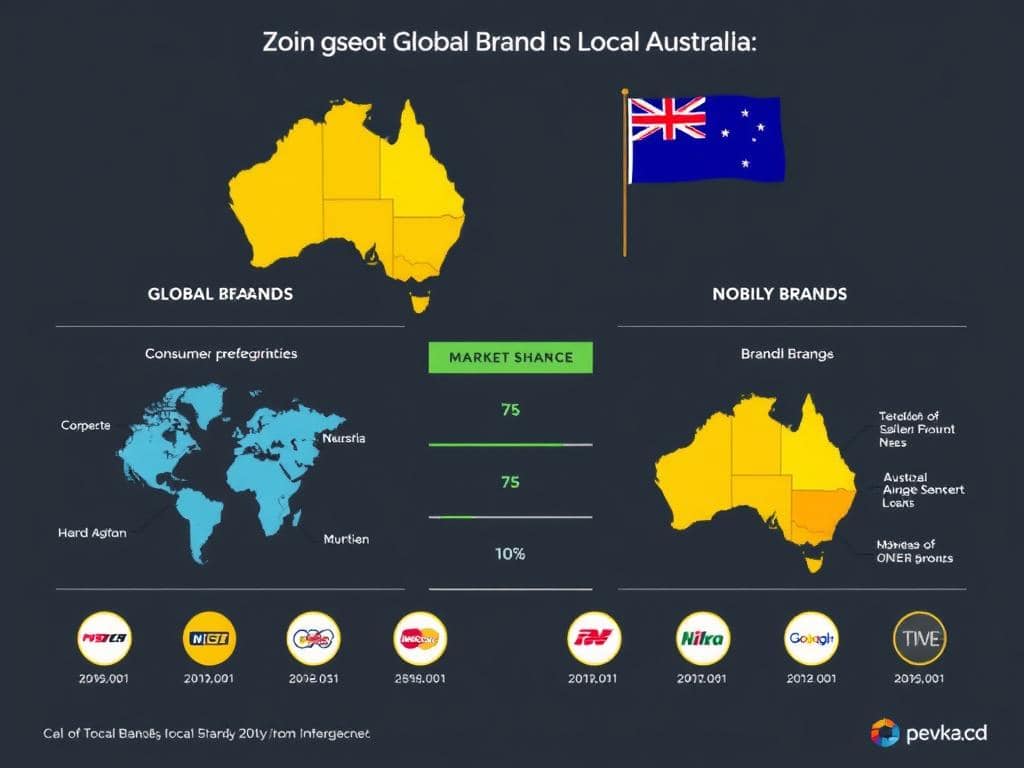Australian consumers are increasingly torn between global powerhouse brands and homegrown alternatives when making purchasing decisions.
In today’s competitive retail landscape, the choice between international brands and local favourites has become more complex, with global brands often commanding premium prices due to perceived quality and prestige.
As savvy shoppers weigh their options, tools like Wispri, Australia’s leading price tracking platform, can help monitor product prices across multiple retailers, sending instant alerts when prices drop.
This comprehensive guide will explore the price differences between local and global brands in the Australian market, examining whether the premium prices of global brands are justified by quality differences.
Key Takeaways
- Australian shoppers face a growing choice between global and local brands.
- Global brands often command higher prices due to perceived quality.
- Local brands may offer better value but struggle with perception gaps.
- Price tracking tools can help consumers make informed purchasing decisions.
- The Australian market presents unique challenges for both global and local brands.
Understanding the Local vs Global Brand Landscape in Australia
The Australian market is characterized by a dynamic interplay between local and global brands. This interplay is influenced by consumer preferences, cultural identity, and market strategies employed by both local and global brands.
The Rise of Global Brands in the Australian Market
Global brands have made significant inroads into the Australian market, bringing with them international marketing strategies and a perceived premium quality. Many global brands have successfully adapted to local tastes, creating a blend of global appeal and local relevance.
The presence of global brands has increased competition, pushing local brands to innovate and strengthen their market positions. This competitive landscape benefits consumers, offering a wider range of choices and driving market growth.
| Brand Type | Market Strategy | Consumer Perception |
|---|---|---|
| Global Brands | International marketing, premium pricing | High quality, aspirational |
| Local Brands | Localized marketing, competitive pricing | Authentic, community-focused |
The Resilience of Local Australian Brands
Despite the influx of global competitors, many Australian brands have shown remarkable resilience. Local brands leverage their understanding of Australian culture and preferences to maintain market relevance.
Local Australian brands often emphasize their “homegrown” status, highlighting Australian ingredients, manufacturing, and employment to appeal to patriotic consumer sentiments. 
- Australian brands have built strong identities around uniquely Australian cultural elements and lifestyle values.
- The COVID-19 pandemic has strengthened support for local businesses, with consumers making conscious decisions to support domestic brands.
- Several Australian brands have successfully expanded internationally while maintaining their Australian identity.
Consumer Perceptions: How Australians View Local vs Global Brands
When it comes to choosing between local and global brands, Australian consumers are driven by a mix of factors including perceived quality and cultural affinity. This complex decision-making process reflects the diverse views Australians hold towards brands, influenced by their individual experiences and the broader cultural context.

The Perceived Quality Gap
Australian consumers often perceive global brands as symbols of quality and prestige. Global brands such as Coca-Cola, Apple, and Mercedes are seen as icons that create a global culture, appealing to consumers who value consistency and high standards. These brands invest heavily in maintaining their image worldwide, which can lead to a perception of superior quality among Australian consumers.
The perceived quality gap between local and global brands can influence purchasing decisions. While local brands are recognized for their understanding of the Australian market and cultural nuances, global brands are often associated with a cosmopolitan lifestyle and advanced technology. This perception can make global brands more appealing to consumers seeking premium products or services.
| Brand Attribute | Local Brands | Global Brands |
|---|---|---|
| Cultural Understanding | Strong understanding of local culture and preferences | May lack specific cultural nuances but offer a global identity |
| Quality Perception | Variable, often seen as good value for money | Generally perceived as high quality and prestigious |
| Marketing Approach | Localized marketing strategies | Standardized global marketing with attempts to localize |
The Cultural Connection Factor
Australian consumers often feel a strong cultural connection to local brands that understand and reflect Australian values and lifestyle. Local brands leverage their Australian identity as a key differentiator, emphasizing their understanding of local preferences and cultural nuances. This connection can evoke a sense of patriotic pride among consumers who view their purchasing decisions as contributions to the national economy.
On the other hand, global brands attempt to forge cultural connections through localized marketing campaigns. While some succeed in resonating with Australian consumers, others may come across as inauthentic. The tension between global appeal and local relevance creates an interesting dynamic where Australians may simultaneously desire the status associated with global brands and appreciate the authentic connection offered by local ones.
The interplay between local and global brands in the Australian market reflects a complex consumer psychology. As consumers navigate their preferences, they weigh factors such as brand identity, cultural connection, and perceived quality. Understanding these dynamics is crucial for both local and global brands seeking to establish a strong presence in the Australian market.
Price Comparison: Are Global Brands Worth the Premium?

Global brands dominate the Australian market, but are they worth the extra cost? The allure of global brands often lies in their perceived quality and prestige. However, local brands are increasingly offering competitive alternatives that challenge the notion that global brands are always the better choice.
Why Global Brands Often Command Higher Prices
Global brands typically come with a higher price tag due to several factors. These include international shipping costs, import duties, and the premium associated with global brand marketing. Australian consumers often associate global brands with higher quality, which makes them more willing to pay the premium.
The prestige associated with global brands also plays a significant role. Consumers tend to identify with the qualities of strong global brands, viewing them as a connection to the global market. This perception justifies the higher prices of global brands in the eyes of consumers.
When Local Brands Offer Better Value for Money
Local Australian brands, on the other hand, offer superior value for money by eliminating the costs associated with global branding. Many Australian-made products offer quality comparable to, or even surpassing, that of global alternatives at lower price points, especially in categories where local manufacturing expertise is strong.
- Local brands provide better after-sales service and customer care due to their proximity to the Australian market.
- Budget-conscious Australian shoppers are recognizing that the performance gap between global and local brands has narrowed.
- Price tracking data shows that local brands offer more frequent and deeper discounts than global brands.
By choosing local brands, Australian consumers can enjoy quality products at competitive prices while supporting local businesses.
Country of Origin Effect on Australian Shopping Decisions
The origin of a product significantly influences Australian consumers’ buying behavior. The country of origin effect is a powerful factor in shaping consumer perceptions and purchasing decisions in Australia.

How “Made in Australia” Influences Purchase Decisions
The “Made in Australia” label can have a positive impact on consumer purchasing decisions. Australian consumers often associate products made locally with certain qualities, such as freshness, reliability, and support for the local economy. This perception can lead to a preference for Australian-made products, particularly in categories like food and beverages.
Australian-made products are often seen as being of high quality, which can justify a premium price in the eyes of consumers. The “Made in Australia” label is a mark of quality and authenticity that resonates with many Australian shoppers.
The Premium Perception of Certain Global Origins
Australian consumers often associate specific countries of origin with expertise in particular product categories. For instance, German engineering is synonymous with high-quality automotive products, while Italian design is associated with fashion and luxury goods. These country-specific associations can create a premium perception that global brands leverage to command higher prices in the Australian market.
The premium perception varies significantly by product category. For example, Swiss watches, German cars, and French perfumes benefit from strong country-of-origin effects that local Australian alternatives struggle to overcome. Australian consumers’ perceptions of country-of-origin quality are evolving, with countries like South Korea seeing dramatic improvements in their brand perception over the past decade in categories like electronics and automotive.
Smart Shopping: Tracking Prices Across Local and Global Brands

Smart shopping has become a reality for Australian consumers, thanks to innovative price tracking solutions that compare local and global brand prices. With the ever-increasing number of choices available in the market, it’s becoming more challenging for shoppers to keep track of the best deals. This is where advanced price tracking tools come into play, helping consumers make informed decisions.
Wispri: Your Price Tracking Companion
Wispri is a cutting-edge price tracking service designed to help Australian shoppers monitor price movements across their favourite local and global brands. With its AI-powered price monitoring system, Wispri ensures that users receive accurate and timely updates on price changes.
The platform’s user-friendly dashboard provides a comprehensive overview of all tracked products, allowing users to monitor price movements across their entire wishlist. Whether you’re loyal to a particular global brand or prefer to shop locally, Wispri helps you stay on top of the best deals.
Setting Up Price Alerts with Wispri
Setting up price alerts with Wispri is a straightforward process that allows Australian shoppers to specify their desired price points for both local and global brand products they’re interested in purchasing. The customizable alert system can be tailored to notify users about any price drop or only when prices fall below specific thresholds.
- Receive notifications when your favourite brand goes on sale
- Monitor price history for local and global brands
- Set target prices for your desired products
Wispri’s free service tier provides essential price tracking functionality, while the Wispri PRO subscription offers advanced features like unlimited price alerts, detailed price history graphs, and priority notifications. By using Wispri, Australian shoppers can maintain brand loyalty while ensuring they never overpay, particularly useful for tracking premium global brands that offer less frequent but sometimes significant discounts.
Conclusion: Making Informed Choices Between Local and Global Brands
The Australian retail landscape is characterized by a dynamic interplay between local and global brands, offering consumers a diverse range of choices. Australian consumers face complex decisions when selecting between local and global brands, with each offering distinct advantages in terms of price, quality perception, cultural relevance, and overall value proposition.
A balanced brand portfolio is ideal for most shoppers, involving the selection of global brands where their premium is justified by genuine quality differences and choosing local brands where they offer comparable quality at better prices. Price tracking tools like Wispri provide objective data, cutting through marketing hype and enabling consumers to make informed purchasing decisions based on actual price movements.
By understanding the strategies behind global and local brand pricing, Australian consumers can become more sophisticated shoppers. The future of retail in Australia will likely see continued competition between global and local brands, with tools like Wispri helping consumers navigate this complex landscape with confidence.
FAQ
What factors influence the price difference between local and international brands in Australia?
The price difference is often influenced by factors such as brand identity, production costs, and market strategies. International brands may command higher prices due to their global branding efforts and perceived quality.
How do Australians perceive the quality of local brands compared to global brands?
Australians generally perceive global brands as being of higher quality, but this perception can vary depending on the product category and the brand image projected by local brands.
Can local Australian brands offer better value for money than global brands?
Yes, local brands can offer better value for money by understanding the consumer preferences and cultural nuances of the Australian market, allowing them to tailor their products and pricing strategies accordingly.
How does the “Made in Australia” label influence consumer purchasing decisions?
The “Made in Australia” label can positively influence purchasing decisions by evoking a sense of national pride and trust in the product’s quality, as well as supporting the local economy.
Are global brands always more expensive than local brands?
Not always. While some global brands may be priced at a premium, others may be competitively priced with their local counterparts, depending on their market strategy and target audience.
How can consumers effectively compare prices across local and global brands?
Consumers can use tools like Wispri to compare prices across different brands and products, helping them make informed purchasing decisions based on their budget and preferences.
What role does cultural connection play in consumer brand choices?
The cultural connection factor plays a significant role, as consumers often prefer brands that resonate with their cultural values and identity, whether it’s a local brand or a global brand that has successfully adapted to local tastes.

